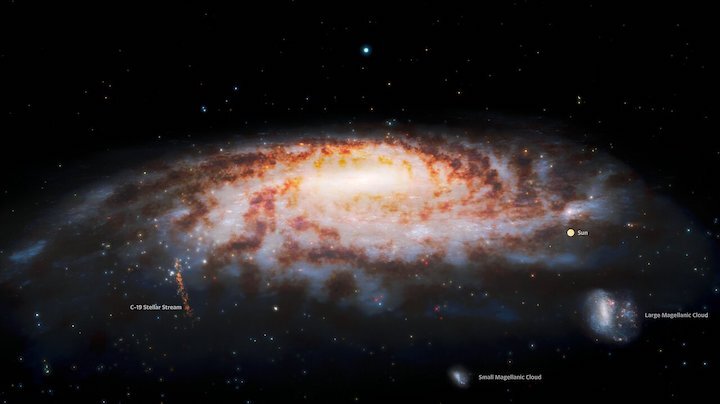8.01.2022
A stream of stars scattered across 15 degrees of sky was once part of a globular cluster torn apart by our galaxy’s gravity. The stars represent some of the oldest in the Milky Way.

This illustration shows the location of the C-19 stellar stream, recently discovered at the edge of our Milky Way Galaxy. The stars in this stream were once part of an ancient globular star cluster that was torn apart by gravitational interactions with our galaxy. The location of the Sun is provided for reference. (The size of the Sun is not to scale.) The Large Magellanic Cloud and Small Magellanic Cloud (satellite galaxies of the Milky Way) appear in the lower right.
International Gemini Observatory/NOIRLab/NSF/AURA/J. da Silva/Spaceengine ; Acknowledgment: M. Zamani (NSF’s NOIRLab)
Astronomers have discovered an ancient celestial ruin. The Milky Way’s gravity long ago rent apart a globular cluster and crumbled its thousands of stars across 15 degrees of sky — the width of three fists held at arm's length. Now, new measurements show that these remains are among the oldest stars ever seen in or around our galaxy.
The Milky Way itself is ancient, having formed some 200 million years after the Big Bang. Eons of star formation have rendered it anew, and “modern” stars such as the Sun litter the spiral galactic plane. But hints of its past remain in globular clusters, which are crowded with stars typically billions of years old. The Milky Way has more than 150 of these spherical star groups, the vast majority of them floating in the vast halo that surrounds the thin galactic plane.
These globular clusters are the oldest structures in the galaxy. We know this because astronomers have measured their stars’ metallicity. “Metals” are what astronomers call elements that are heavier than hydrogen and helium (the simple gases that suffused the infant universe). Forged in the bellies of stars, metals’ abundance increases over cosmic time, so a star’s metallicity is a proxy for its age.
But while the Milky Way’s globular clusters are undeniably old, it seems none have survived from the earliest days of galaxy assembly. Their metallicity bottoms out at 0.2% of the metals found in the Sun. That contrasts with isolated stars in the halo, a few of which have been found to be far more metal-poor.
The discovery of a celestial ruin may shed light on ancient globulars’ disappearance. In the January 6th Nature, Nicolas Martin (University of Strasbourg, France and Max Planck Institute for Astronomy, Germany) and colleagues report a detailed study of a collection of stars in the Milky Way halo dubbed C-19. Based on their data, the researchers conclude these stars were probably once a globular cluster torn apart as it passed too close to our galaxy.
The observations show that C-19 contains 8,000 Suns’ worth of mass in stars, making it relatively small as globular clusters go. But it’s no longer globular — the Milky Way’s gravity has stretched its collection of stars like taffy. This stellar stream orbits the Milky Way on a relatively close polar orbit that takes it in and out of the galactic plane in less than half a billion years. At its closest, the stream comes within 23,000 light-years of the galactic center; the stars turn around in their orbits at 88,000 light-years away. (The stream is currently 60,000 light-years from the Sun.)
Team member Rodrigo Ibata (also at University of Strasbourg) led the discovery of this stream, among others, by employing a computer algorithm to the massive data set collected by the European Space Agency’s Gaia satellite. The team then followed up with multiple ground-based telescopes, ultimately obtaining detailed spectroscopy of eight stars using the Gemini-North telescope on Mauna Kea, Hawai‘i, and the Gran Telescopio Canarias on La Palma in the Canary Islands.
The spectra confirmed earlier estimates: The stars of this disintegrated cluster have extremely low metallicities, just 0.05% of that found in the Sun — much lower than found in any existing globular cluster to date. “Such a low global metallicity has so far never been observed for any stellar system in the Milky Way, in its surroundings or beyond,” the researchers write.
C-19’s close orbit suggests it joined the Milky Way system fairly early on, in the first couple of billion years of our galaxy’s existence. (In fact, that anything coherent has survived until today is somewhat of a puzzle, the researchers acknowledge.) The ancient remains confirm that globular clusters could form early on. It’s just that the ones from our galaxy’s earliest years generally didn’t survive the tumultuous gravitational environment.
“This artifact from ancient times,” says team member Julio Navarro (University of Victoria, Canada), “opens a direct and unique window onto the early epochs of star formation in the universe.”
Quelle: Sky&Telescope
